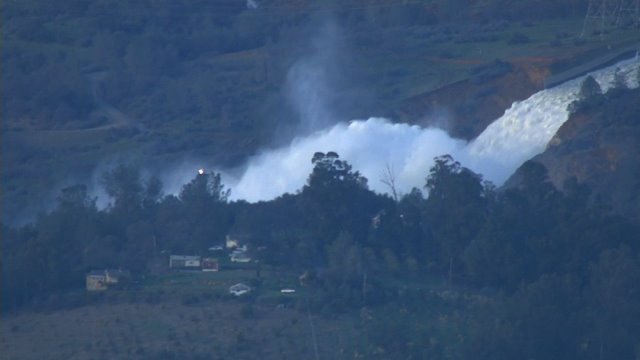Environmental groups warned 12 years ago that the nation’s tallest dam in California was an imminent disaster.
They worried that heavy rain and fast-rising waters could overwhelm the main concrete spillway of the Oroville Dam, overflow the emergency spillway and flood communities downstream.
They were ignored.
And this weekend, some of their fears were realized.
Ron Stork, policy director with Friends of the River, a Sacramento environmental group, said state and federal officials were told to reinforce the spillway.
“We urged them to put concrete on the spillway — our argument was that without a proper spillway, the hillside would wash away and cause catastrophic flooding,” Stork said.
A perfect storm of events led this month to the failure of the dam, which provides flood control for the region.
“Extreme hydrologic events precipitated this near-disaster,” said Blake Paul Tullis, a professor of Civil and Environmental Engineering at Utah State University.
First, powerful storms dumped rain and snow across California.
The high waters caused Lake Oroville’s level to rise to the top, and the water couldn’t be drained fast enough.
Erosion left a hole almost the size of a football field and at least 40-feet deep in the main concrete spillway.
As the diverted water flowed into the emergency spillway for the first time in the nearly 50 years since it was built, it began to erode.
Millions of gallons began washing over this emergency spillway, essentially an embankment covered with brush, trees and rock.
“Any spillway — primary or emergency — usually has some kind of protection, a concrete basin,” said Tullis. “For structures as big as this, it seems pretty uncommon to not have some protection at the base of the spillway.”
Authorities ordered mass evacuations for some 188,000 people, out of concern the spillway could fail and send walls of water roaring downstream. The sudden evacuations sent residents into a panic.
“It was a slow moving crisis that picked up a lot of speed yesterday,” Stork said on Monday.
Stork said he had seen this coming way back in October when Friends of the River, along with the Sierra Club and the South Yuba Citizens League, filed a motion with the Federal Energy Regulatory Commission (FERC) as part of Oroville Dam’s re-licensing process.
In the motion, they argued that the Oroville Dam — which was completed in 1968 and owned by the state of California — did not meet modern safety standards.
They stressed in the motion that the auxiliary spillway was designed to work with a replacement dam that was never built. Without that new dam, the Oroville Dam’s auxiliary spillway was designed to be used in in a controlled, infrequent way and not in an emergency capacity, they said.
The energy regulatory commission rejected their motion to re-inforce the emergency spillway with concrete.
Stork said money was an issue.
A response filed by the State Water Contractors and the Metropolitan Water District of Southern California said FERC, which issues the licenses, could not require them to pay the damages required for the upgrades.
The filing also said that flood control arguments were “misdirected and unsupported” due to routine dam safety checks and the uncertain effects of climate change on the river basin.
The acting director of the California Department of Water Resources, Bill Croyle, said he was “not familar with 2005 documentation or conversation” about spillway concerns.
At a news conference Monday afternoon, he said that no water was overflowing the emergency spillway and lake levels were continuing to fall.
Crews were breaking and bagging rocks to drop into the hole eroded in the auxillary spillway, officials said.
The solution now is to fix the broken main spillway in the summer, said Professor Tullis and Stork of the environmental group.
“If the department is unwilling or unable to keep the reservoir down so that it does not spill, then we could face the same catastrophic circumstance again,” Stork said.
